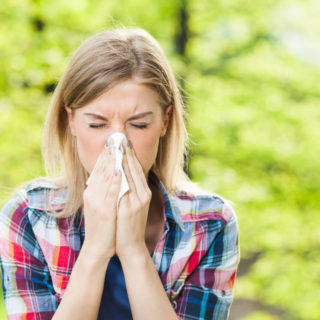The Air in Your Home Could Be Aggravating Your Allergies – What You Can Do
Allergic reactions happen when the immune system reacts abnormally to a foreign substance. When you have seasonal allergies during the spring, it’s often because there is a high amount of pollen particles in the air outdoors.
With each breath, these particles enter your body through the respiratory tract. This can cause symptoms such as runny or stuffy nose, sneezing, red and watery eyes, swelling around the eyes, and itchiness around the nose, eyes, ears, and mouth.
With the abundance of weather and allergy apps available these days, you can easily check to see if the air quality is good or bad before you walk out the front door. But what about indoors? How do we prevent pollen and other allergens from reaching us inside our homes? Start with these three air-clearing tips:
- Keep windows closed on high-pollen days.
While there’s usually nothing wrong with letting a little fresh air into your space, it’s something you’ll want to be careful about in spring if you suffer from seasonal allergies.
When you leave your windows open, the particulate matter (pollen in this case) that is outdoors makes its way inside your home. If you have fans or your HVAC running, this will quickly circulate pollen throughout your home and leave you breathing in pollen.
On high-pollen days, cleaning with outside air coming in could be counterproductive due to high particulate matter stemming from the pollen count. So, it is always recommended cleaning with the doors and windows closed during allergy season. This is another reason to use cleaning products without harsh chemicals that require ventilation to avoid inhaling the fumes, such as bleach.
- Tend to water damage.
Like pollen, mold can create tiny particles that can pass right through the respiratory tract and enter the bloodstream.
If you’ve recently had a water-damage event, you could have mold or harmful bacteria particles circulating in the air in your home. For many people, exposure to these can produce an allergy-like reaction. That’s why it’s always important to take care of water damage.
If you have water damage, call your insurance company right away if you have one, (as it may be covered by insurance) and ensuring that someone is there within 24 hours to remove the wet building material. Some molds can grow in as quickly as 24 hours. Once the wet building material is removed, it’s important to make sure the surrounding area stays dry. Dehumidification is recommended over air movers (another piece of water-damage equipment), as air movers could unintentionally blow mold and/or toxins around.
If you think the water may have intruded for longer than a 24-hour period, then you will want to hire a professional mold remediation firm to remove the building material under the proper engineering controls (with personal protective equipment, plastic containment, and air scrubbers). Reacting as quickly as possible is the best way to ensure that the problem doesn’t get bigger and cause adverse health reactions from neglecting to dry the space properly within the first 24 hours.
Cleaning up with just a towel is not enough as water can remain trapped between building substrates for longer periods of time, even after the surface itself is dry. Think about what happens if you leave a wet towel on the floor. The floor underneath the towel stays wet for a long period of time because it traps moisture between the floor and the towel. This is what happens between your walls and floors when there is a substantial leak.
- Change your HVAC filters.
Think of your heating and air conditioning system as the lungs of your home.
Clogged HVAC filters are ineffective at cleaning the air and can recirculate allergens throughout your home. If these particles become recirculated and continue to be aerosolized, they can get into the respiratory tract through breathing.
Whether you rent or own your home, switching out HVAC filters is something you’ll want to do every three months. Some people may have main return boxes with filter grilles in a common area like a hallway where you can easily change out the filter. Others may have their filter located at the HVAC unit itself in the return duct right next to the unit. It’s uncommon that you’d have both, but it’s always good to double-check.
It is also recommended that you have your HVAC equipment and ductwork thoroughly cleaned by a professional once annually. The best time to clean it is during seasonal transitions, when you’re going from using the heat to the air conditioning. Doing it at the start of spring will help you breathe easy for the rest of the season.
If you need help finding an allergist in your area to diagnose, treat and manage allergies, asthma or immunologic disorders, including primary immunodeficiency disorders, please visit our Find a Doctor page on our website.



Leave a Reply